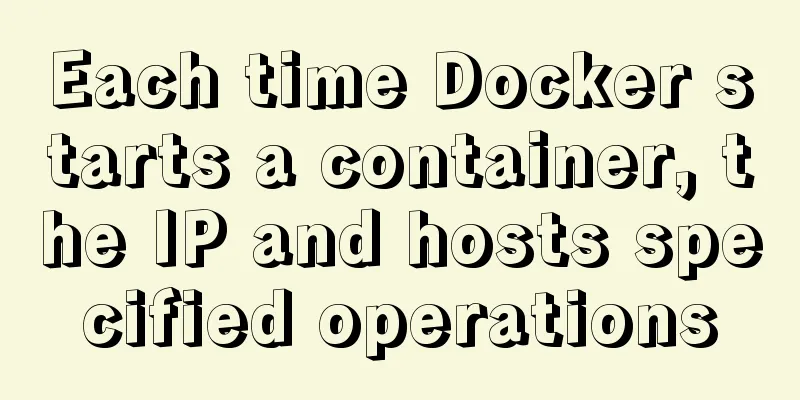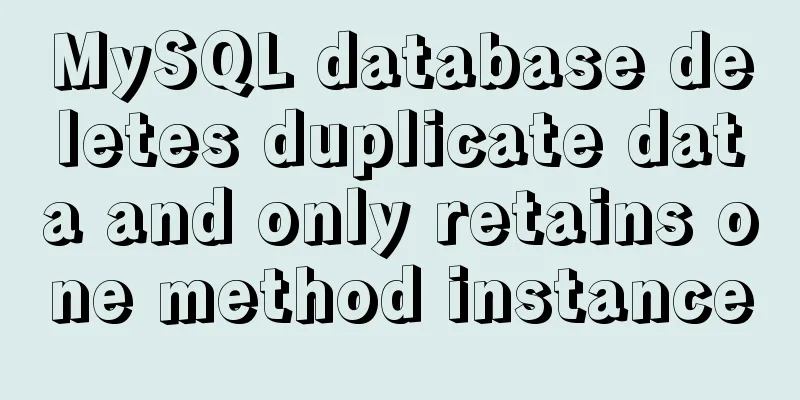Each time Docker starts a container, the IP and hosts specified operations

PrefaceEvery time you use Docker to start a Hadoop cluster, you need to rebind the network card, fix the IP, and modify the /etc/hosts file. This is very troublesome, so I want to explore the cause and optimization. 1. Reasons/etc/hosts, /etc/resolv.conf and /etc/hostname, these three files in the container do not exist in the image. When starting the container, these files are mounted into the container in the form of mount. Therefore, if these files are modified in the container, the modified parts will not exist in the top layer of the container, but will be written directly to these three physical files. Why do the changes disappear after restart? The reason is: every time Docker starts a container, it rebuilds a new /etc/hosts file. Why is this? The reason is: the container is restarted, the IP address is changed, and the original IP address in the hosts file is invalid. Therefore, the hosts file should be modified, otherwise dirty data will be generated. 2. SolutionSpecify the IP and hostname each time you start the container, and add hosts to /etc/hosts. The command is as follows: docker run -itd --name hadoop0 --hostname hadoop0 --net network_my --ip 192.168.10.30 --add-host hadoop1:192.168.10.31 --add-host hadoop2:192.168.10.32 -d -P -p 50070:50070 -p 8088:8088 hadoop:master Docker network mode and configuration operations --hostname : specify hostname; --net: Specify network mode --ip: Specify IP --add-host : Specify the host to be added to /etc/hosts The above commands require docker version 1.9 or above;After starting the container, enter the container to view /etc/hosts [root@centos-linux-7 /]# docker exec -it hadoop0 bash [root@hadoop0 /]# cat /etc/hosts 127.0.0.1 localhost ::1 localhost ip6-localhost ip6-loopback fe00::0 ip6-localnet ff00::0 ip6-mcastprefix ff02::1 ip6-allnodes ff02::2 ip6-allrouters 192.168.10.31 hadoop1 192.168.10.32 hadoop2 192.168.10.30 hadoop0 [root@hadoop0 /]# The above command is too long and can be written as a shell script. There are several other ways mentioned online:1. Use Dockerfile to build an image 2. Start using docker-compose 3. Modify the configuration file of the environment variables that the docker container starts to load publicly (I didn't find the configuration file for my version) The first method should not work. Although Dockerfile can set relevant environment variables when building an image, as mentioned earlier, IP, hostname, and /etc/hosts are all reloaded, so they must be specified when the Docker container is started. Those in the image are not acceptable. The second one, I am not familiar with docker-compose yet, and I will not discuss it in depth for the time being; The third one is inconvenient for me, because it is public and cannot be personalized for different containers; To sum up, I think it is most convenient to specify through the command line when the container is started, but the disadvantage is that the command line is too long. But you can just write it as a shell script! Supplement: Linux Docker sets a fixed container IP (Docker default container IP will change) 1. Create your own network type and specify the network segmentOrder docker network create --subnet=172.18.0.0/16 mynetwork 2. Specify your own network IP when the image is startedOrder docker run -itd -p 5001:5001 --name image name --net mynetwork --ip 172.18.0.2 --privileged=true --restart=always -d image name 3. Restart Docker and view container IPRestart dockers Order service docker restart View All Containers Order docker ps -a View container information Order docker inspect container name This way the container IP will not change
The above is my personal experience. I hope it can give you a reference. I also hope that you will support 123WORDPRESS.COM. If there are any mistakes or incomplete considerations, please feel free to correct me. You may also be interested in:
|
<<: HTML dl, dt, dd tags to create a table vs. Table creation table
>>: Vue realizes simple effect of running light
Recommend
Install MySQL in Ubuntu 18.04 (Graphical Tutorial)
Tip: The following operations are all performed u...
Node.js makes a simple crawler case tutorial
Preparation First, you need to download nodejs, w...
How to use anti-shake and throttling in Vue
Table of contents Preface concept Stabilization d...
Example of how to embed H5 in WeChat applet webView
Preface WeChat Mini Programs provide new open cap...
Write a formal blog using XHTML CSS
The full name of Blog should be Web log, which mea...
Project practice of deploying Docker containers using Portainer
Table of contents 1. Background 2. Operation step...
A brief discussion on the role and working principle of key in Vue3
What is the function of this key attribute? Let’s...
Understanding and example code of Vue default slot
Table of contents What is a slot Understanding of...
Vue encapsulates the public function method of exporting Excel data
vue+element UI encapsulates a public function to ...
Simple encapsulation of axios and example code for use
Preface Recently, when I was building a project, ...
Detailed explanation of the use of mysql explain (analysis index)
EXPLAIN shows how MySQL uses indexes to process s...
How to embed other web pages in a web page using iframe
How to use iframe: Copy code The code is as follo...
A brief analysis of the difference between ref and toRef in Vue3
1. ref is copied, the view will be updated If you...
In-depth understanding of JavaScript event execution mechanism
Table of contents Preface The principle of browse...
Detailed explanation of the principle of creating tomcat in Eclipse
When creating a tomcat server on a local eclipse,...










